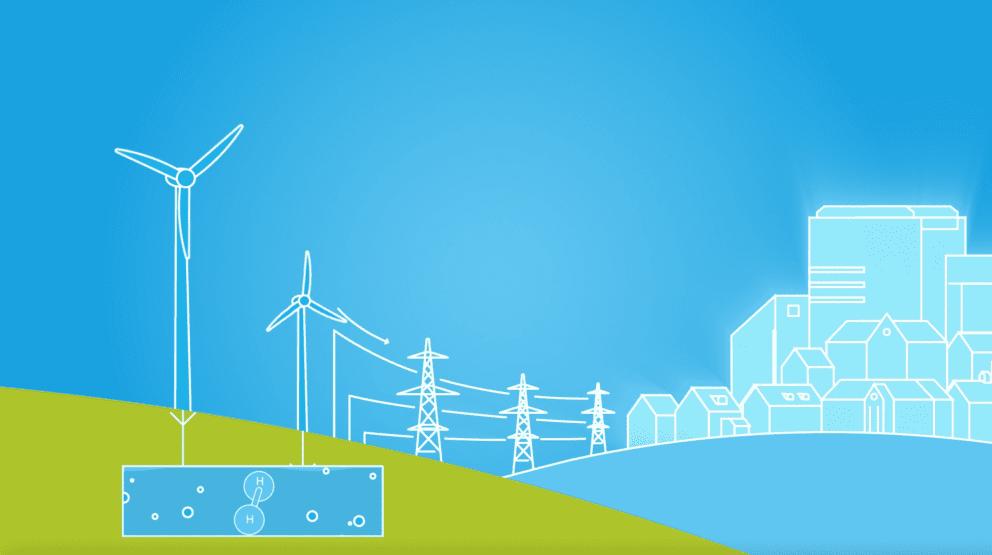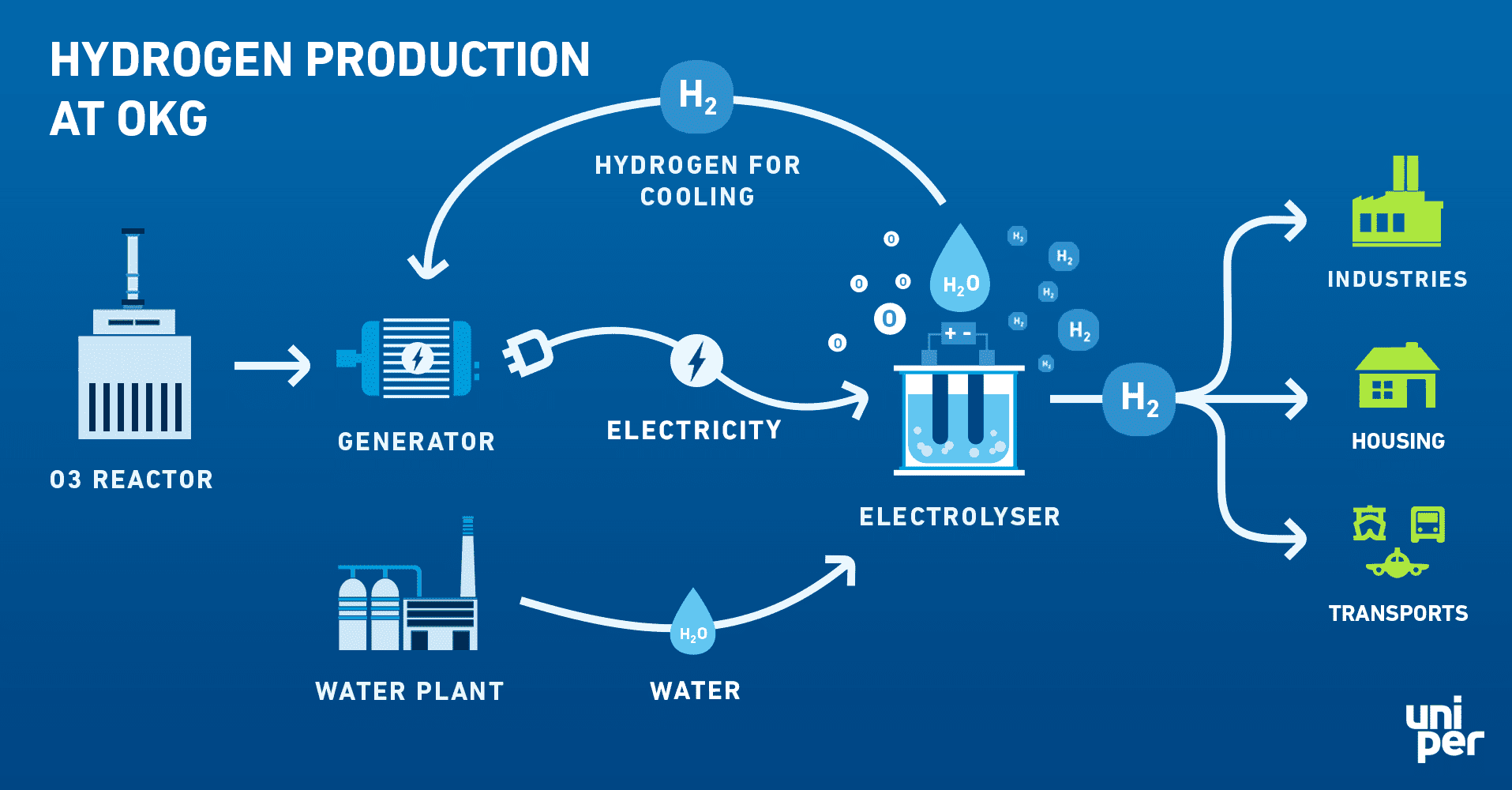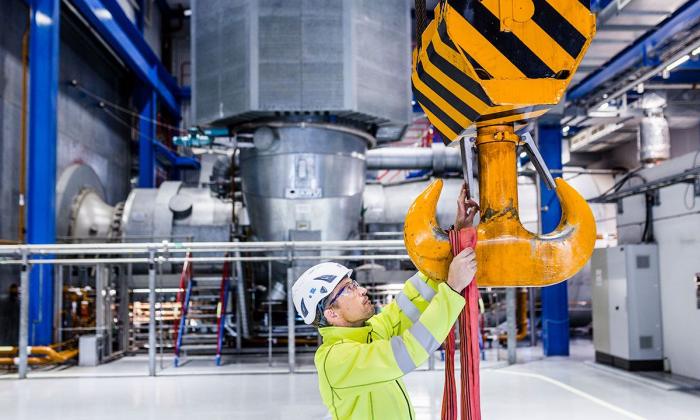
Hydrogen in Sweden
What is hydrogen?
Hydrogen is the most common element in the world. Hydrogen (H₂) is a molecule containing two hydrogen atoms and acts as an energy carrier, just like electricity. Hydrogen is neither fossil-free nor fossil-based in itself – it all depends on how it is produced. Fossil-free hydrogen is produced using electricity from, for example, hydropower or wind power.
Hydrogen is a chemical compound of two hydrogen atoms (H2), which is also the most common element we know of. Hydrogen is odorless, colorless, and highly flammable. Hydrogen is very volatile, which means that it quickly dissolves in the air and becomes harmless.
When hydrogen comes into contact with oxygen, large amounts of energy are released. The residual product is ordinary water, as hydrogen (H2) reacts with oxygen (O) to form H2O.
In order to use hydrogen as fuel, electricity, or heat, an energy converter is needed. This could be a fuel cell, for example, a type of energy converter that can be used to convert the chemical energy of hydrogen into electricity. The residual product is pure water, while heat is also generated in the process that can be recovered.
Climate change in society is one of the greatest challenges of our time. We need many different solutions that together reduce emissions and create a fossil-free future. Hydrogen is one of these solutions.
How hydrogen is produced
There are several methods for producing hydrogen. The most common ways to produce hydrogen are either through steam reforming, methane pyrolysis, or a process called electrolysis.
Steam reforming
The most common method today is steam reforming of natural gas. The natural gas is heated to between 700 and 1,100 degrees Celsius, which, in combination with a catalyst, causes water vapor to react with the methane in the natural gas (CH4) and form carbon dioxide and hydrogen. The disadvantage of this method is that it produces large amounts of carbon dioxide emissions. The advantage is that it costs less.
Methane pyrolysis
In methane pyrolysis, natural gas is heated to over a thousand degrees and allowed to bubble through a molten metal catalyst. The methane (CH4) is then split into two hydrogen molecules and one carbon atom. The carbon atom can then be stored in solid form and is not released into the atmosphere. The advantage of this method is that it converts a fossil fuel into hydrogen without producing carbon dioxide. The method is relatively new and needs to be further developed in order to be scaled up to industrial scale.
Electrolysis
In an electrolyzer, water is split into hydrogen and oxygen using electricity. The electrolyzer contains two electrodes – one with a positive (anode) and one with a negative (cathode) charge. The cathode is often covered with platinum so that positively charged atoms that migrate across it can be reduced, which occurs when they receive electrons from the cathode surface. When they are reduced, hydrogen gas is formed. At the anode, negatively charged atoms release electrons. This causes oxidation and oxygen is formed.
If fossil-free electricity is used in the electrolyzer, the hydrogen gas is climate-friendly. The disadvantage is that the efficiency is relatively low, with approximately 20-30 percent of the energy content being lost in the conversion from electricity to hydrogen gas. However, research and development is ongoing to improve efficiency. By 2030, it is estimated that losses can be reduced to between 14 and 18 percent.

What is hydrogen used for?
Hydrogen is an energy carrier with many different uses. Hydrogen has been used as a raw material in industry for over 100 years, mainly in the chemical industry, for example to produce ammonia.
Hydrogen in combination with a fuel cell can, for example, be used to power a vehicle. Hydrogen can also be used as a backup power system for base stations and telephone exchanges, for example, to reduce the vulnerability of the telecommunications network in the event of storms or other disruptions.
In Sweden, it is estimated that hydrogen will primarily be used in the process industry, for example to produce fossil-free steel. Heavy transport, which is difficult to electrify, is another area with great potential. A third area is the use of hydrogen to even out peaks and troughs in the electricity system.
Process industry
Hydrogen can be used in the process industry to replace fossil energy, among other things. In the production of steel, for example, large amounts of coal or natural gas are currently used, which react chemically with the iron ore. The challenge has been to find a fossil-free manufacturing method. This is where hydrogen comes in as a solution.

Unipers work with hydrogen
At OKG outside Oskarshamn, we have been producing fossil-free hydrogen since 1992. The electrolyzer has a capacity of 0.7 MW, and the hydrogen is produced using electricity from the nuclear power plant and water from the nuclear power plant's own waterworks. Hydrogen is used at OKG to cool generators, while surplus production is currently sold on a purely commercial basis.

In Östersund, Uniper is running the NorthStarH2 project – a step towards fossil-free industry and shipping. Here, e-methanol is developed using hydrogen from electricity and water, together with captured biogenic carbon dioxide from renewable sources.
BothniaLinkH2 is an interesting future project that Uniper is running together with the Port of Luleå. The plan is to establish a regional hydrogen hub in Luleå where hydrogen is produced based on wind power, and where the hydrogen can be used in the regional process industry, converted into electrofuel for ship fuel, or exported.
Uniper is a partner in Liquid Wind, which will produce the electrofuel eMethanol from hydrogen and biogenic carbon dioxide.
A Swedish hydrogen strategy is emerging
Sweden has unique conditions for becoming a hydrogen country, with good access to fossil-free electricity and biogenic carbon dioxide. To succeed, a clear strategy for infrastructure, technology choices, and financing is needed. Uniper is actively working to pave the way for a competitive and sustainable hydrogen market.


